Why a Warehouse System Is Non-Negotiable
Imagine running a small workshop where you make custom phone cases. You have ten designs, a couple of shelves, and you can eyeball stock levels. Fine. Now scale up to hundreds of designs, multiple colours, and daily online orders. Suddenly:
- Packages get lost.
- You run out of best-sellers without warning.
- You’re fumbling through bins, wasting time and money.

A proper Warehouse Management System (WMS) solves this by:
- Tracking Every Item – Knows exactly how many of each SKU you have, down to the bin or shelf .
- Directing All Moves – Automatically suggests the best available bin for new stock and the optimal picking location when an order comes in .
- Recording Every Action – Logs put-aways, picks, transfers, adjustments; audit trails are built-in
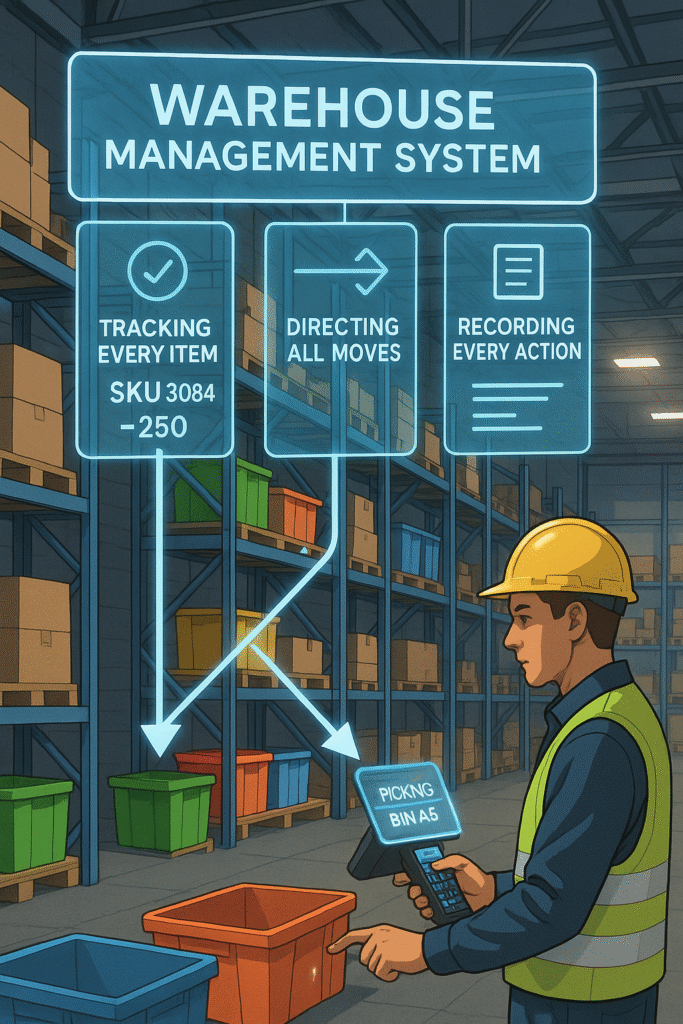
Without these capabilities, you’re at high risk of:
- Stockouts – Promising products you don’t have.
- Overstock – Wasting cash on inventory that sits idle.
- Inefficiency – Workers spending extra hours hunting items.
Bottom line: if your operation stretches past a handful of SKUs and a few orders a day, a WMS isn’t a luxury—it’s a necessity.
Matching System Complexity to Your Needs
Not every warehouse demands the full power of SAP EWM. Here’s how to decide:
A. Bare-Bones Handling
- Example scenario’s:
Bulk Grain Supplier
A grain elevator buys wheat from farms and ships it directly to flour mills. There’s no shelving—just giant silos. They need to record incoming/outgoing tonnages, but they don’t track individual bags or bins.
Construction Aggregate Yard
A sand-and-gravel yard receives truckloads of aggregate, stores them in huge piles by type, and loads directly into customer trucks. No pallets, no discrete bins—just volume measurements and inventory tags. - Storage Need: Almost zero—no shelving or bins.
- Solution: Basic ERP inventory accounting; no WMS required .
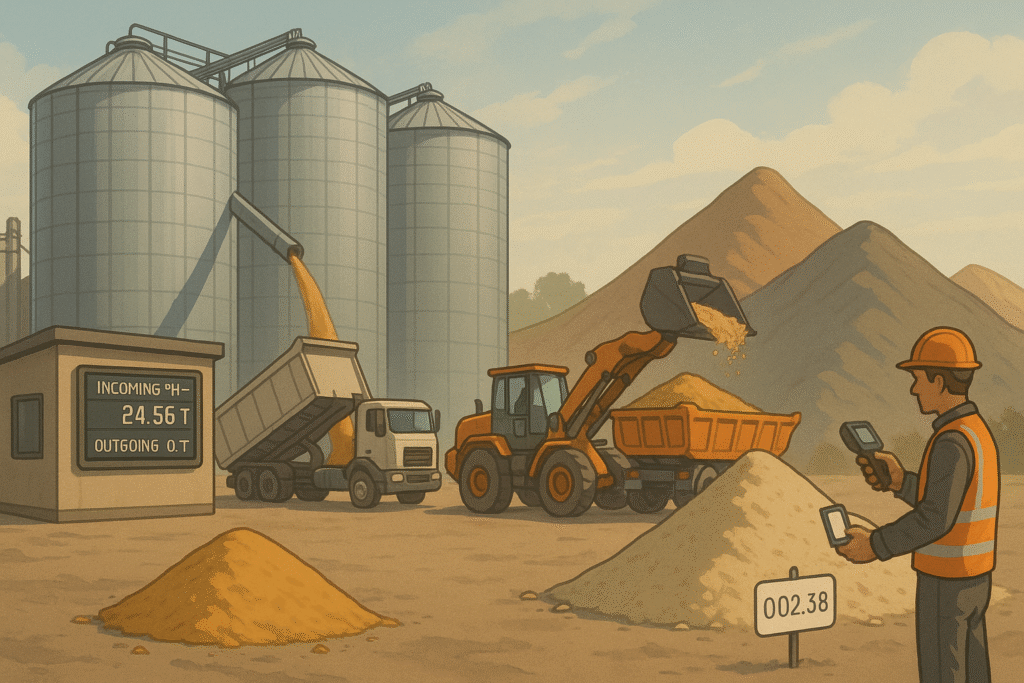
B. Basic Bin Control
- Example scenario’s:
Craft Brewery
A small brewery ferments beer in tanks, then bottles it into crates. They store crates on five fixed pallet locations. When a new batch arrives, they always put it on one of those five spots—no dynamic bin searches.
Computer Assembly Shop
A local PC builder stocks motherboards, CPUs, RAM sticks in a few set rack slots. They don’t need to shuffle parts around; they always pull from the same shelf when building machines.
(In both B scenarios, you need to know which fixed slot holds each SKU, but you don’t need software to determine the “best” bin on the fly.) - Storage Need: A handful of fixed bins or pallet spaces.
- Solution: Lean WM in SAP ERP—uses fixed bins, no dynamic bin searches and eventually (2025)❗ you will need to change to Stock Room Management. ❗
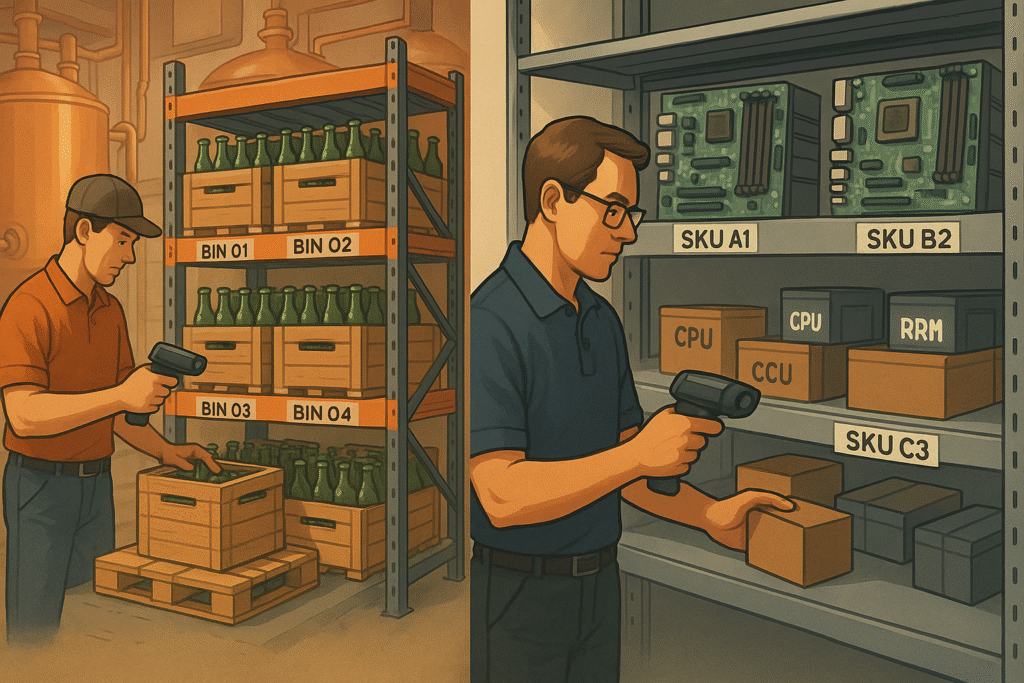
C. Full Bin-Level Management
- Scenario: Regional distributor juggling hundreds of SKUs across dozens of bins.
- Storage Need: Precise bin tracking, need to optimise space.
- Solution: Classic WM (LE-WM) in SAP ECC—uses transfer orders for all stock moves, integrates with RF devices and eventually (2027) ❗ you will need to choose between: Stock Room Management or SAP EWM (Embedded or Decentralised) .❗

D. Complex Fulfilment and Value-Added Services
- Scenario: Third-party logistics (3PL) centre handling thousands of SKUs, repackaging, cross-docking, yard traffic, and automated conveyors.
- Storage Need: Advanced slotting, wave picking, kitting, yard management, and real-time labour tracking.
- Solution: SAP EWM (embedded in S/4HANA or as a standalone Decentralised system).
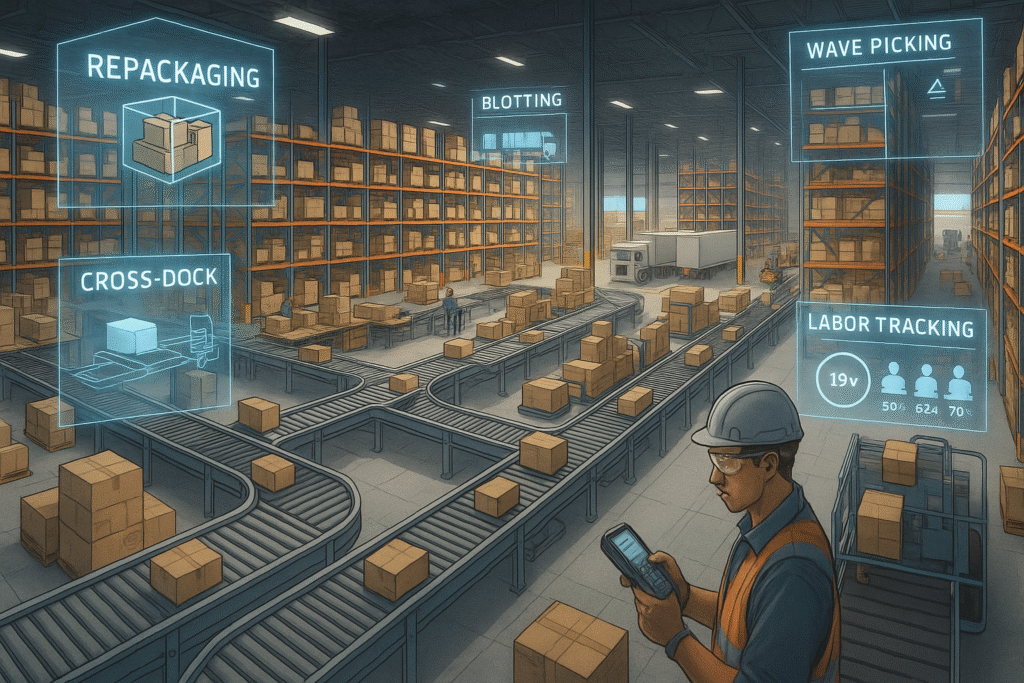
The Four Flavors of SAP Warehouse Management
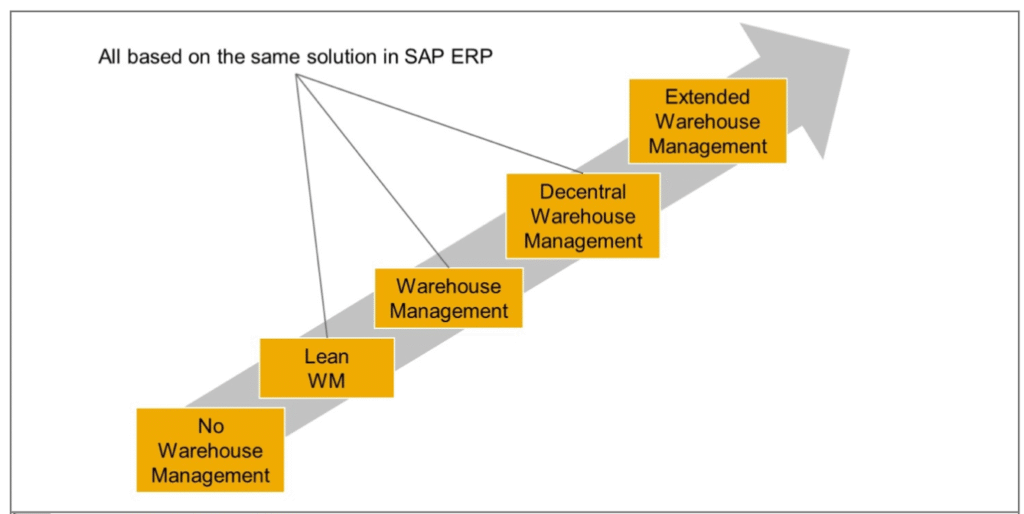
| Feature / Flavor | ERP Inventory Mgmt | Lean WM (in ERP) | Classic WM (LE-WM, in ECC) | SAP EWM (S/4 Embedded or Decentralised) |
| Where it runs | Core ERP only (no WM module) | Core ERP only (Lean WM) | ERP (ECC) separate WM module | Embedded in S/4 or separate SCM/S/4 box |
| Bin-level tracking* | ❌ not at bin level | ✅ Fixed bins only | ✅ Full bin-level | ✅ Full bin-level |
| Bin-Level Control* | ❌ No logic, stock only tracked at storage location | ✅ Static only, fixed bins, no dynamic suggestions | ✅ Basic logic, next empty bin, section indicators | ✅ Advanced logic, rules, constraints, product class, FIFO, etc. |
| Bin-level Inventory* | ❌ No, stock tracked at storage location level | ⚠️ Limited, material assigned to fixed bin only, no quant tracking | ✅ Basic quants per bin | ✅ Yes, full quant control, batch, stock type, HU, etc. |
| Dynamic bin determination* | ❌ manual | ❌ manual | ✅ via transfer orders | ✅ via advanced putaway strategies |
| Transfer orders* | ❌ | ⚠️ Only partial process, no true transfer orders | ✅ Standard WM transfer | ✅ (plus handling-unit tasks) |
| RF integration | ❌ | ❌ | ⚠️ Limited RF support via custom dev or add-ons | ✅ |
| Slotting & reslotting | ❌ | ❌ | ❌ | ✅ (push & pull) |
| Cross-docking | ❌ | ❌ | ❌ | ✅ |
| Yard management | ❌ | ❌ | ❌ | ✅ |
| Value-added services* | ❌ | ❌ | ❌ | ✅ |
| Labour management | ❌ | ❌ | ❌ | ✅ |
| MFS / automation* | ❌ | ❌ | ⚠️ Limited, very basic support; lacks native MFS, no PLC integration | ✅ (conveyors, AS/RS integration) |
| Best suited for | Micro-business, <10 SKUs | Small warehouses, fixed-bin logic, basic fixed-bin strategy, light picking | Midsize ops, RF + basic automation, Full bin-level operations, RF & TOs | High-volume, complex warehouses, 3PLs, 24×7 ops, automation |
| End of mainstream support | N/A | Dec 2025 | Dec 2027 | Ongoing |
| Post-Support Replacement | N/A | Stock Room Management | Stock Room Management or EWM (embedded or decentralised) | N/A – continues in S/4HANA |
- *Bin-level tracking: The system shows which storage bin each product is stored in, offering visibility at the bin level.
- *Bin-Level Control: SAP suggests or determines which bin to use for putaway or picking, based on configured strategies.
- *Bin-Level Inventory: The physical stock held in each bin, including quantity, batch, and stock type, is managed and recorded in the system.
- *Transfer orders: Instructions within a system to physically move stock from one bin to another, forming the basis of internal warehouse movement.
- *Dynamic bin determination: The system automatically proposes the most suitable bin for putaway or picking during warehouse processing.
- *Value-added services: Additional activities like labelling, packing, or assembly performed during warehouse operations before shipment or storage.
- *MFS / automation: Material Flow System enables SAP EWM to communicate with automated systems like conveyors or AS/RS for real-time movement control.
EMBEDDED EWM VS. DECENTRALISED EWM
Embedded and Decentralised EWM differ in how they are deployed, how they handle data, and how they impact system uptime and performance. The table below highlights these key differences.
| Aspect | Embedded EWM (S/4HANA) | Decentralised EWM (SCM* or S/4HANA) |
| System Landscape | Unified (ERP + EWM in one system) | Two-system architecture |
| Installation | Same system as ERP | Separate system (via middleware) |
| Database | Shared tables with ERP | Own tables, data replicated |
| Master Data Flow | Direct access (no CIF) | Via CIF* / DRF* |
| Transaction Flow | Internal triggers (same instance) | Via qRFC* or IDoc* between ERP & EWM |
| Upgrade & Patching | One upgrade cycle | Independent cycles |
| Availability | ERP downtime = EWM downtime | Can operate independently |
| Performance | Competes with ERP | Dedicated performance for warehouse |
| Data Sharing | Native shared tables | Replication via CIF*/qRFC*/IDoc* |
| Best for | Simpler ops, tight ERP link | High-volume, automation, 24/7 uptime |
*SCM: The end-to-end discipline that plans, executes and controls the flow and storage of materials from origin to consumption.
*CIF: The middleware syncing master and transactional data between SAP ERP and EWM.
*DRF: Files that act as the queuing mechanism that bundles and holds those records until ERP processes them.
*qRFC: A guaranteed, sequential remote-function-call mechanism that lines up EWM-to-ERP requests in a queue and processes them in strict order.
*IDoc: SAP’s standard asynchronous data container for system-to-system messaging, wrapping each transaction (e.g. delivery creation or stock update) for monitoring, error handling and reprocessing).
Which Path to Pick?
1. Do you only need basic stock management?
➡️ Fixed bins only?
➡️ No RF, no automation, no HUs?
Yes ➤ ✅ Lean WM (in ERP)
🗓 Mainstream support ends: Dec 31, 2025
🔁 Replacement: Stock Room Management in S/4HANA ➤ ❗ No roadmap for innovation ❗
⬇️ I need more ⬇️
🔹 2. Do you need RF + full bin-level tracking?
➡️ RF guns, queues, batch handling?
➡️ Classic WM strategies and staging?
Yes ➤ ✅ Classic WM (ECC)
🗓 Mainstream support ends: Dec 31, 2027
🔁 Replacement:
Eventually you will need to choose between:
✅ SAP EWM (Embedded or Decentralised)
or
✅ Stock Room Management in S/4HANA ➤ ❗ No roadmap for innovation ❗
⬇️ I need more ⬇️
🔹 3. Are you moving to S/4HANA, but don’t need advanced WM?
➡️ Just need a basic WM fallback in S/4?
➡️ No automation, no innovation required?
Yes ➤ ✅ Stock Room Management in S/4HANA
🧭 Replacement solution for Lean WM & Classic WM in basic use cases❗ No roadmap for innovation: ❗
⬇️ I need more ⬇️
🔹 4. Do you require advanced warehousing functions?
➡️ RF, Handling Units, Yard Management, Cross-Docking, VAS, MFS, Labour Management?
Yes ➤ ✅ SAP EWM (Embedded or Decentralised)
🔹 5. What type of EWM deployment suits you best?
a) Do you want maximum uptime or automation?
Yes ➤ ✅ Decentralised EWM (Separate instance, dedicated resources)
b) Do you prefer simpler setup and tight ERP integration?
Yes ➤ ✅ Embedded EWM (S/4HANA)
Why ❗ “No roadmap for innovation” ❗when mentioning “Stock Room Management”
Stock Room Management is not a new WM solution. It’s SAP’s legal workaround to keep Classic WM processes alive in S/4HANA — but only in a very limited form.
Here’s what each line in that phrase means:
“Replacement solution for Lean WM & Classic WM in basic use cases”
This means:
- If you’re migrating from Lean WM or Classic WM, and your warehouse setup is simple (e.g., no RF, no automation, no advanced putaway), you can use Stock Room Management as a transitional solution inside S/4.
- It’s technically compatible with S/4HANA and uses the same old WM logic.
- So it acts as the “drop-in replacement” for basic WM needs — but nothing more.
❗ “No roadmap for innovation” ❗
This is SAP’s official position:
- Stock Room Mgmt will not receive any new features.
- No support for: RF, Yard Management, Labour Management, HU-managed storage, EWM integration, etc.
- It exists only to help customers complete their S/4 migration if they’re still using WM.
In other words:
✅ It keeps you legally compliant and technically functional during your move to S/4.
❌ But it’s not a long-term strategy.
What’s Standard vs. What’s EWM-Only
All SAP warehouse solutions (ERP WM, Lean WM, Classic WM, and EWM) provide these fundamentals:
- Putaway: Assign incoming stock to bins.
- Picking: Guide workers to the right bins for outbound orders.
- Stock Transfers: Move goods between bins or storage types.
- Physical Inventory: Cycle counts and adjustments.
Only SAP EWM delivers:
- Slotting & Reslotting – Dynamically optimise bin assignments based on throughput.
- Cross-Docking – Instantly route inbound goods to outbound docks.
- Yard Management – Track trucks, staging areas, and gate operations.
- Value-Added Services – Repackaging, labelling, kitting workflows.
- Labour Management – Task-based performance metrics and optimisation.
- RF/RFID & Automation – Deep integration with mobile devices, conveyors, AS/RS.
- Complex Internal Routing – Multi-step transport sequences handling handling units (HUs).
